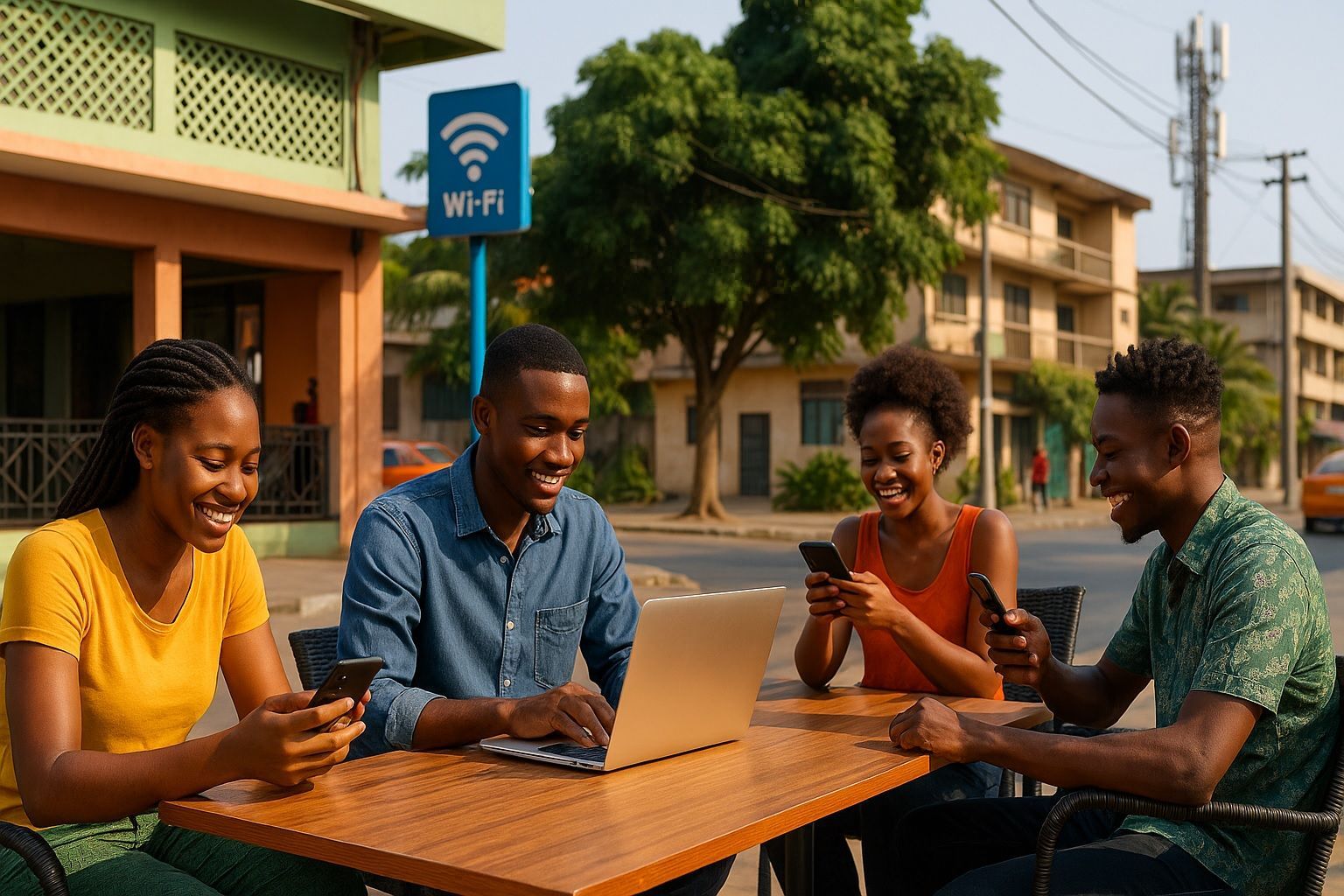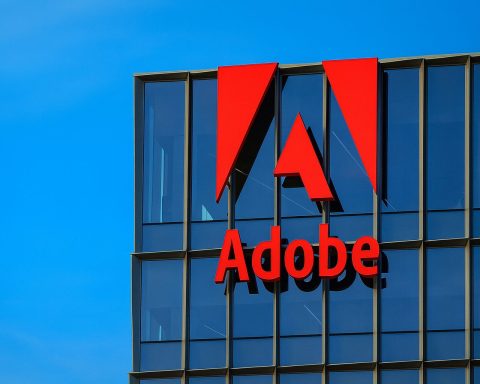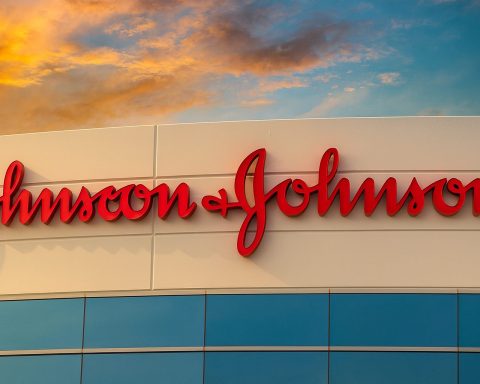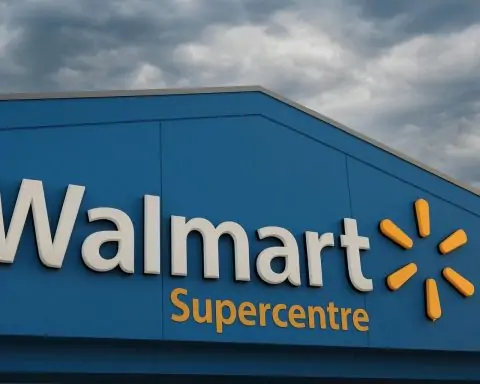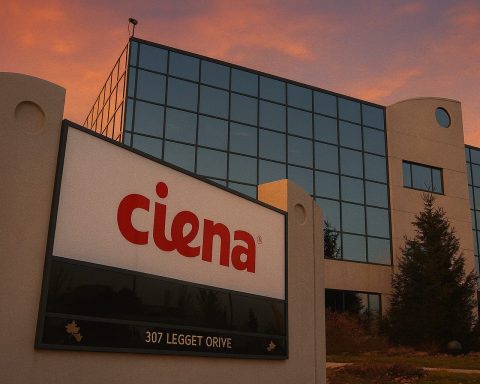- As of 2024, about 53.4% of Ivorians live in urban areas, while urban internet usage is roughly 50% compared with 22% in rural areas.
- Côte d’Ivoire has laid over 5,200 km of fiber under the RNHD backbone, targeting nearly 7,000 km by September 2025.
- The country is connected to the ACE and WACS submarine cables, and the 2Africa mega-cable is expected to land in 2023–2024, adding about 180 Tbps design capacity.
- By 2023, about 92% of Ivorians had access to at least one 4G network.
- MTN Côte d’Ivoire began 5G trials in 2021 and launched first 5G sites in late 2023, with commercial 5G planned for January 2024.
- Eutelsat Konnect offers consumer satellite plans starting from 9,000 CFA per month (about $15) for 512 kbps.
- Starlink has not been approved to operate in Côte d’Ivoire as of 2024 due to licensing and regulatory concerns.
- Orange Côte d’Ivoire holds about 43–44% of mobile subscriptions and leads fixed broadband, while MTN has about 33–34% and Moov about 22%.
- There were 11.2 million internet users in early 2024 (about 38.4% of the population), and roughly 7.0 million social media users (about 24%).
- As of 2025 Côte d’Ivoire has 5 active data centers, including at least one Tier III facility in Abidjan, with the Abidjan IXP linking about 35% of locally exchanged traffic.
Côte d’Ivoire is undergoing a digital transformation, rapidly expanding internet infrastructure and connectivity across the country [1]. Fueled by government ambition to become a West African digital hub [2], investments in fiber-optic networks, mobile broadband, and even satellite internet are reshaping how Ivorians access the online world. Internet usage has grown from only a fraction of the population two decades ago to roughly 38–41% of citizens today [3], but significant gaps remain between urban and rural areas. This report provides a comprehensive look at Côte d’Ivoire’s internet access landscape – from ultra-fast fiber in city centers to innovative satellite projects for remote villages – covering infrastructure status, key providers, usage trends, affordability, policies, recent developments, and how the country stacks up against its West African peers.
Internet Infrastructure Status
Urban vs. Rural Connectivity
High-speed internet access in Côte d’Ivoire reflects an urban-rural divide. Over half of Ivorians live in urban areas (about 53.4% as of 2024) [4], and cities like Abidjan enjoy extensive 3G/4G coverage and growing fiber deployments. In urban centers, about 50% of the population uses the Internet, compared to only 22% in rural areas [5]. Major cities benefit from multiple mobile operators and fiber rings, while rural communities often rely on basic 2G/3G connections or shared facilities. In remote regions, broadband access and high-speed connectivity are frequently absent [6], due to the higher cost of infrastructure deployment and sparse populations. This urban-rural gap means many rural Ivorians still lack reliable internet for e-commerce, e-learning, or digital banking [7]. Bridging this divide has become a national priority, with initiatives underway to extend coverage beyond cities through rural fiber backbones, microwave links, community Wi-Fi hubs, and pilot projects using satellite connectivity [8].
National Fiber Backbone and Submarine Cables
Côte d’Ivoire has made remarkable progress in building out its fiber-optic backbone, now ranking 3rd in Africa for fiber infrastructure development (behind only Mauritius and South Africa) [9]. Backed by major public and private investments, over 5,200 km of fiber have been laid under the government’s National Broadband Network project (RNHD), aiming for nearly 7,000 km by late 2025 [10]. Telecom operators have also contributed – by 2023 Orange, MTN, and Moov together deployed more than 24,000 km of fiber to connect cities and mobile towers [11]. This fiber expansion is improving fixed broadband availability (previously just ~1% of people had fixed internet access) [12] and enabling high-speed services like fiber-to-the-home in parts of Abidjan.
Fiber-optic deployment has accelerated: Côte d’Ivoire climbed from 8th to 3rd in Africa on a global fiber index in one year, surpassing larger economies. A government-led program is rolling out a nationwide fiber backbone (7,000 km target) with full activation expected by September 2025 [13] [14]. Private operators have also laid tens of thousands of kilometers of fiber, connecting cities and cell towers to high-capacity backbones.
On the international front, Côte d’Ivoire is connected to multiple submarine cables that provide vital global internet bandwidth. The country has landing stations for the Africa Coast to Europe (ACE) cable and the West Africa Cable System (WACS) [15], which significantly boost available bandwidth and reduce latency for Ivorian internet users. These undersea cables link Abidjan to Europe, North America, and other African markets, ensuring more resilient connectivity. Importantly, a new mega-cable, 2Africa, is expected to land in Côte d’Ivoire by 2023–2024 [16]. The 2Africa cable (one of the world’s largest subsea projects) will dramatically increase international capacity and help the country further integrate into the global digital network [17]. Côte d’Ivoire is also pursuing redundant links by connecting to neighboring countries’ networks and any future regional cables, which provides backup in case one route experiences an outage [18]. Overall, a combination of domestic fiber backbone rollout and international submarine cables is strengthening the nation’s internet infrastructure backbone.
Mobile Broadband Coverage (3G, 4G, 5G)
Mobile networks are the primary conduit for internet access in Côte d’Ivoire, and their coverage has become extensive. Virtually the entire population is covered by at least a 2G signal, and 3G/4G mobile broadband networks reach most populated areas. By 2023, about 92% of Ivorians had access to at least one 4G network [19], a remarkable expansion since 4G was first launched in 2016. All three major operators (Orange, MTN, and Moov) have invested heavily to extend 3G and 4G base stations across the country [20] [21]. Orange Côte d’Ivoire claims 4G coverage in all districts of Abidjan and key regional cities, and was covering roughly 23% of the country’s land area with 4G by end-2021 [22] [23]. MTN and Moov similarly report rapidly growing 4G footprints. These investments mean that for a majority of Ivorians – even in smaller towns – mobile broadband is available, if not necessarily affordable to all. Mobile connectivity has driven internet adoption far beyond what the tiny fixed-line network could achieve.
Looking ahead, Côte d’Ivoire is now on the cusp of 5G. MTN Côte d’Ivoire conducted pilot tests of 5G as early as 2021 and announced it would launch commercial 5G services by January 2024 to coincide with the Africa Cup of Nations tournament [24]. The company began deploying 5G sites in Abidjan and select inland cities in preparation [25]. Orange, the market leader, has likewise been preparing for 5G and is expected to follow suit; Orange Group indicated Côte d’Ivoire is on its roadmap for African 5G deployments by end of 2024 [26]. As of mid-2025, 5G coverage remains in trial stages (less than 1% of the population was within a 5G signal in 2023) [27], but rollout will accelerate in urban centers once licenses and spectrum are fully allocated. The planned introduction of 5G is set to support advanced use cases (smart city applications, industrial IoT, HD streaming) and offer much faster wireless broadband, although device cost and network reach will limit 5G’s immediate impact to urban elites. In parallel, operators continue to densify 4G networks and upgrade 3G sites to 4G, since 4G will remain the workhorse of mobile internet access for the next several years.
Satellite Internet Initiatives
Because extending fiber or cell towers to every remote village is costly and slow, satellite internet is emerging as an important piece of the access puzzle. The Ivorian government recognizes that innovative solutions like satellite broadband could help connect hard-to-reach communities and reduce the digital divide [28]. Traditionally, satellite internet in Côte d’Ivoire has been used by businesses, banks, and international organizations via VSAT (Very Small Aperture Terminal) links. Various global providers (e.g. Vizocom, GlobalTT, Syntelix) offer VSAT services in the country [29] [30], typically targeting enterprises or NGOs willing to pay a premium for connectivity in areas with no terrestrial networks. For example, banks often use satellite as backup connectivity for remote branches, and mining or agricultural companies use it at sites deep in the interior.
Recently, there is growing interest in consumer-oriented satellite internet. Eutelsat’s Konnect service now covers Côte d’Ivoire, delivering Ka-band satellite broadband to individual customers. Konnect advertises packages starting from about 9,000 CFA per month (≈$15) for entry-level usage, and “unlimited data” plans from 30,000 CFA/month (≈$50) for a 512 kbps connection [31] [32]. Higher tiers offer up to 5 Mbps for about 84,000 CFA (≈$140) monthly [33]. While these prices are far above typical mobile data bundles, they provide an always-on connection option for rural communities, schools, or clinics off the grid. The government, through the universal service fund (ANSUT), has also explored installing satellite-based community Wi-Fi hubs in some villages to provide shared internet access [34]. Such initiatives are in early stages but illustrate the potential of satellites to reach the final frontiers of connectivity.
A major development on the horizon is Starlink, the low-Earth orbit (LEO) satellite internet service from Elon Musk’s SpaceX. Starlink promises high-speed, low-latency broadband via a constellation of thousands of satellites. However, as of 2024 Starlink faced regulatory hurdles in Côte d’Ivoire and had not been approved to operate [35]. The Ivorian regulator (ARTCI) has been cautious, citing concerns over licensing, control, and competition. In fact, Starlink has been blocked from approval in at least seven African countries – including Côte d’Ivoire, Burkina Faso, DR Congo, South Africa, and Senegal – pending compliance with local regulations [36]. Authorities are wary of an unregulated rollout and often require conditions like local partnerships or partial local ownership for licensing [37]. Starlink’s experience in Africa suggests that while governments acknowledge the value of satellite connectivity for rural areas, they also want to ensure oversight and protect domestic telecom markets [38]. It remains to be seen if Côte d’Ivoire will soften its stance; in some countries, bans were later reversed after negotiations [39]. If eventually authorized, Starlink could provide a game-changing option for remote Ivorian homes or businesses with its 100 Mbps speeds – albeit at a high price ($600 equipment + $80–100/month service). Until then, satellite internet in Côte d’Ivoire will likely remain the realm of specialized VSAT providers and targeted projects to connect underserved regions.
Key Internet Service Providers
Côte d’Ivoire’s internet access market is served by a mix of mobile network operators, fixed broadband ISPs, and satellite service companies. The telecommunications sector was liberalized in the 1990s, allowing multiple players, though it has consolidated to three main mobile operators today [40]. Below are the key service providers enabling Ivorians to get online:
- Orange Côte d’Ivoire – The market leader in both mobile and fixed services. Orange entered the market by merging with the former state monopoly (Côte d’Ivoire Telecom) in 2010 [41]. It now commands about 43–44% of mobile subscriptions [42] [43] and an even larger share of fixed-line and broadband connections. Orange has the widest network coverage, including extensive 3G/4G coverage (all major cities and many towns) and it was first to launch 4G in 2016. The company also provides fiber-to-the-home/business in parts of Abidjan and other cities, and DSL in some areas, making it the dominant fixed broadband provider. Orange CI has invested significantly in expanding infrastructure – including international cables and a new Orange Digital Center in Abidjan to spur innovation [44] [45]. It is also a leader in mobile money (Orange Money) which is widely used nationwide. In summary, Orange is the incumbent powerhouse, leading in revenue (about 50% of sector revenue in 2021) [46] and network quality.
- MTN Côte d’Ivoire – The second-largest operator, with roughly 33–34% of mobile market share [47] [48]. South Africa’s MTN Group runs MTN CI, offering mobile voice/data and some fixed solutions (primarily for enterprises and as an ISP for corporate clients). MTN has nationwide 2G/3G coverage and has aggressively expanded 4G since obtaining a license; it reportedly covers most urban areas and many secondary towns with 4G. MTN was the first to trial 5G in Côte d’Ivoire and has been spearheading the 5G rollout (planned commercial launch in 2024) [49]. The company also focuses on rural connectivity programs and is a major player in mobile financial services (MTN Mobile Money). With its “Ambition 2025” strategy, MTN aims to be the leading digital services provider in Africa [50] – in Côte d’Ivoire this translates to investments in network upgrades, fintech, and digital content partnerships. MTN’s strong backing and regional experience make it a formidable competitor to Orange.
- Moov Africa Côte d’Ivoire – The third mobile operator, holding about 22% of the mobile market [51]. Moov is part of the Maroc Telecom group (branded as “Moov Africa” across several countries). It offers mobile voice and data services, having rolled out 3G and 4G relatively later than its rivals. Moov does not operate legacy fixed-lines, but it has started offering some fixed 4G wireless broadband solutions in urban areas. In recent years Moov has grown its subscriber base and invested in network expansion to compete more strongly outside of urban centers. In Q4 2021, for example, Moov actually led in capital expenditure, accounting for 39% of total mobile network investment that quarter (outspending Orange and MTN) [52]. Its strategy has included aggressive pricing and promotions (which contribute to many Ivorians using multiple SIMs to chase offers [53]). While smaller in market share, Moov’s presence ensures a three-way competition that helps drive innovation and pricing moderation in the mobile sector.
- Other ISPs and Operators – Beyond the “big three” mobile carriers, Côte d’Ivoire has a few additional players in the internet ecosystem:
- KoZ – A mobile virtual network operator (MVNO) that leases capacity to offer its own mobile plans [54]. KoZ was one of the early alternative mobile brands, though its market presence is small compared to the main operators.
- VipNet – A domestic ISP specializing in fixed internet for businesses and homes [55]. VipNet provides services like corporate broadband, VSAT connectivity, and enterprise networks. It capitalizes on segments not fully served by Orange’s fixed division.
- YooMee – A fixed wireless broadband provider using technologies like WiMAX/4G Wi-Fi for home internet [56]. YooMee (originally from Cameroon/Switzerland) entered the Ivorian market to offer wireless home broadband in select cities, targeting users who needed high-speed internet but couldn’t get fiber or DSL.
- Satellite Providers – Though not traditional “ISPs” on the ground, satellite operators do serve Ivorian customers. Konnect (Eutelsat) has local distributors offering satellite home internet plans as noted above. Global VSAT firms (e.g., Viasat, SES/O3b, Avanti) also have footprints – for instance, O3b satellites (medium Earth orbit) have been used in Africa to connect mobile towers or towns, and such capacity could be leveraged by Ivorian telcos for backhaul in remote areas. As of 2025, these satellite options remain niche and often facilitated via partnerships with Ivorian telecom or ICT companies.
Overall, Orange, MTN, and Moov dominate the retail internet access market, collectively serving virtually all of the 12+ million internet users in the country [57] [58]. Smaller ISPs and satellite firms play supporting roles in specific niches or regions. The competitive dynamic among the top three (with Orange in a strong lead) has pushed operators to improve service quality and expand coverage – ARTCI has even fined operators for poor service and once revoked underperforming licenses to keep the market in check [59]. This competition, coupled with regulatory pressure, has contributed to better offerings (like bigger data bundles at lower cost) for consumers over time.
Internet Penetration and Usage Trends
User Growth and Demographics
Internet use in Côte d’Ivoire has been on an upward trajectory, driven almost entirely by mobile connectivity. There were approximately 11.2 million internet users in Côte d’Ivoire at the start of 2024, equivalent to about 38.4% of the population [60] [61]. This represents steady growth from earlier years – for example, penetration was around 34–36% in 2020, rising to ~41% by 2023 [62] [63]. In absolute terms, about 278,000 new users came online between 2023 and 2024 [64]. Despite this progress, over half the population remains offline, meaning there is plenty of room for further growth. The current internet penetration in Côte d’Ivoire (≈40%) is roughly on par with the African average (~38%) [65], but lags behind some regional peers (more on that in a later section).
The usage gap is pronounced across different segments of society. There is a significant gender gap in internet access: only about 34% of Ivorian women used the internet in 2022, compared to 43% of men [66] [67]. Cultural factors, lower digital literacy, and income disparities contribute to fewer women going online. Age is another factor – Côte d’Ivoire has a very young population (median age 18), and it’s largely youth and working-age adults who are online; older and less educated people in rural areas are the least connected. As noted earlier, location matters greatly: urban residents are more than twice as likely to use the internet as rural residents (50% vs 22%) [68].
Most Ivorians access the internet via mobile phones, and increasingly, via smartphones. The mobile penetration rate in the country is well above 100% (reflecting multiple SIM ownership) – with about 43.6 million cellular connections active in early 2024, equal to 149% of the population [69]. However, not all of those are data subscriptions; in 2020, smartphone penetration was estimated at about 45% of the population [70]. That figure has likely grown with the influx of affordable Android devices and Chinese phone brands. Still, it implies that a sizable number of mobile users are on basic phones without internet capability. Expanding the base of smartphone owners (through lower-cost devices and financing options) is critical to boosting internet adoption further.
Internet usage patterns in Côte d’Ivoire mirror global trends in some ways – social media, messaging, and video streaming are extremely popular among those online. As of January 2024, there were 7.0 million social media users in the country (about 24% of the population) [71]. Platforms like Facebook (7 million users) and WhatsApp are widely used for communication, commerce, and entertainment [72] [73]. Ivorians, especially youth, are active on YouTube, Instagram, and TikTok, and there’s a growing community of digital content creators and influencers in Abidjan [74] [75]. The rise of mobile money (with about 40% of adults having mobile money accounts) is also tied to internet and mobile use, enabling everything from peer-to-peer transfers to online shopping [76] [77]. However, advanced usage like e-commerce and e-learning is still nascent, partly due to trust and infrastructure issues [78] [79].
Broadband Speeds and Quality of Service
For those who are connected, the quality of internet service has been improving markedly. According to Ookla Speedtest data, as of early 2024 the median mobile internet download speed in Côte d’Ivoire was about 24.8 Mbps, and the median fixed broadband speed was 58.9 Mbps [80] [81]. These figures represent a significant jump over the previous year – mobile speeds increased by ~36% year-on-year, while fixed broadband speeds leaped by over 50% [82]. The improvements can be attributed to 4G network upgrades, fiber deployments, and investments in backhaul capacity. A median mobile speed of 25 Mbps means that everyday activities like HD video streaming, video calls, and large file downloads have become much more feasible on cellular connections (at least in areas with good coverage and when not congested). Meanwhile, nearly 59 Mbps median on fixed lines indicates that fiber-to-the-home and other high-speed services are taking hold among urban subscribers – a speed that can support heavy data use and multiple users per household comfortably.
It’s worth noting that these are median speeds; actual experience varies widely by location and provider. In cities, 4G users often report speeds from 10 Mbps up to 50+ Mbps depending on network load, whereas in rural areas 3G users might still be limited to 1–5 Mbps or even EDGE speeds in the worst cases. Fixed broadband is still a luxury for most – only a small minority have home fiber or ADSL – but where available (e.g., parts of Abidjan), gigabit fiber plans exist for businesses and affluent consumers. The steady improvement in speeds shows that operators are not only expanding coverage but also adding capacity (e.g., deploying additional 4G spectrum, installing more base stations, upgrading to LTE Advanced, etc.). The presence of multiple submarine cables and ISPs building out their own fiber backbones has also reduced international bandwidth bottlenecks, making global content faster to access. Additionally, content delivery networks and caches have begun to appear; about 25% of popular web content can be reached on local servers or caches within Côte d’Ivoire [83] [84], which helps speed up access to things like Google, Facebook, and Akamai-served content. Quality of service is an area the regulator ARTCI monitors closely – they have fined operators over dropped calls and slow data in the past [85], pushing telcos to maintain performance standards.
In terms of network coverage quality, by 2023 about 87% of mobile connections in Côte d’Ivoire were broadband (3G or above) [86], showing the migration from 2G to 3G/4G. The few remaining 2G-only areas are typically very remote or low-population zones. Call and data reliability in cities is generally good, though urban users do face occasional congestion at peak times. One continuing challenge is electricity reliability – power outages in certain areas can knock out cell towers (though many have battery or generator backups). Also, during heavy rain seasons or natural disasters, both mobile and fixed networks can experience downtime. The government’s push for improved infrastructure includes hardening networks for resilience and ensuring redundancy (for example, the drive for multiple submarine cables so a single cut doesn’t isolate the country [87]).
Overall, both access and quality have a positive trajectory: more Ivorians are coming online each year, and they are getting faster connections to do more online. The next challenge is to sustain this momentum and extend these gains to those still offline or on the margins of the network.
Pricing and Affordability
Affordability of internet services in Côte d’Ivoire has improved in recent years, although cost remains a barrier for lower-income populations. Mobile data prices in particular have seen a downward trend thanks to competition among operators and expanded network capacity. As of 2023, the average price of 1 GB of mobile data in Côte d’Ivoire was about $1.18 (USD) [88]. This is relatively inexpensive by global standards (placing Côte d’Ivoire roughly 110th cheapest out of 237 countries surveyed) [89]. It also marks a big reduction from a few years ago – for context, in 2017 the price of 1 GB was around 6–7% of monthly GNI per capita [90], whereas today 1 GB costs the average Ivorian only about 1.5% of their monthly income [91]. This figure (1.51% of GNI for a basic data package) is below the UN Broadband Commission’s affordability target of 2% [92], indicating that entry-level mobile internet is now technically “affordable” for the average user in Côte d’Ivoire.
In practice, operators offer a range of prepaid data bundles that make internet access flexible. Users can buy daily packs (e.g., 200 MB for a few hundred CFA) or monthly bundles (e.g., 5 GB or 10 GB plans) depending on what they can afford. This prepaid, bite-sized model allows people with irregular incomes to get online when they need it without large upfront costs. Promotions are frequent – for example, bonus data at night, social media passes, or zero-rated services for certain apps. As a result, even those who can’t afford a smartphone data plan continuously can often find a way to access specific services (like Facebook or WhatsApp) at low cost. Public Wi-Fi hotspots are less common, but some exist in city centers or universities, often sponsored by telecom companies or the government, providing free or cheap Wi-Fi access to those nearby.
For fixed broadband, the story is different – home internet via ADSL or fiber is far more expensive and largely out of reach for the average household. An entry-level fiber or ADSL plan (if available in your neighborhood) might cost on the order of 20,000–30,000 CFA per month (~$30–$50), which only wealthier families or businesses can afford. Installation fees and equipment costs add to the barrier. Consequently, most Ivorians rely on mobile internet for personal use. The government and private sector have tried some community internet initiatives, like cybercafés and telecenters in the past, but with mobile phones now ubiquitous, cybercafés have dwindled in popularity.
The cost of smartphones and devices is another facet of affordability. A brand-new mid-range smartphone can cost several months’ income for low-earning Ivorians. To address this, second-hand phones are very popular (used phone markets thrive in Abidjan’s marketplaces), and there are inexpensive Android devices on the market (some Chinese brands or stripped-down models) sometimes priced under $50. Mobile operators occasionally partner with device manufacturers for installment payment plans or offer subsidized phones for users who commit to data plans, helping more people upgrade from basic phones. Additionally, the government has worked with partners to lower import duties on ICT devices and encourage local retail of affordable smartphones.
In terms of value for money, Ivorians are seeing more data for the same money each year. For example, a few years ago 1,000 CFA might have bought 200 MB of data; today it can buy perhaps 1 GB, depending on the operator’s bundles. This trend is crucial because as people get a taste for internet services, their data consumption grows (video, in particular, eats a lot of data). Indeed, mobile data usage per subscriber has been rising as prices fall – a pattern seen across Africa. Despite these gains, for the roughly 30% of Ivorians living in poverty, even $1 for 1 GB can be a significant expense, meaning they will use the internet sparingly. Efforts like free basics (limited free access to certain services) or cheaper “social bundles” help somewhat, but more needs to be done to ensure the poorest can also benefit from connectivity.
One aspect of affordability the government is targeting is the cost of extending networks to rural areas, which affects retail prices. Through ANSUT, subsidies are provided to telecom operators to build towers and fiber in unprofitable rural locales, with the goal that this will eventually allow more rural users to come online at reasonable prices. International bandwidth costs have also dropped with new submarine cables and shared regional infrastructure, which trickles down to cheaper ISP transit costs and thus consumer prices. The presence of an Internet Exchange Point (IXP) in Abidjan encourages local traffic exchange and reduces the need for expensive international transit for domestic content [93]. All these factors contribute to a gradual improvement in the affordability environment.
To summarize, mobile internet in Côte d’Ivoire is now among the more affordable in Africa, approaching global affordability benchmarks [94]. The average Ivorian can purchase modest data packages within a reasonable share of income, although usage may still be constrained by budget for the lower-income segment. Continued competition between Orange, MTN, and Moov – along with smart regulatory policies (like reducing sector taxes or promoting infrastructure sharing) – will be key to further lowering prices and increasing data allowances. The country’s affordability outlook is positive, as evidenced by forecasts that internet penetration could reach upwards of 60–67% by 2025 [95] if current trends in price and investment continue, bringing digital access to millions more Ivorians.
Government Policies and Regulatory Environment
National Digital Strategy and Vision
The Ivorian government has placed digital development at the heart of its economic strategy. Côte d’Ivoire’s National Digital Economy Development Strategy (2021–2025) – also known as the Stratégie Nationale du Numérique 2020–2025 – lays out an ambitious roadmap to accelerate digital transformation across all sectors [96]. This strategy envisions Côte d’Ivoire as a regional digital hub and is built on several key pillars [97]:
- Expansion of Digital Infrastructure: Invest in broadband networks (fiber backbone, metropolitan fiber, mobile broadband) to improve coverage nationwide, including in rural areas, and prepare for new technologies like 5G [98]. This includes completing the national fiber optic backbone (RNHD) and increasing international bandwidth via new cables.
- Promotion of Innovation and Entrepreneurship: Support tech startups and ICT entrepreneurs through incubators, tech hubs, funding programs, and favorable policies [99]. Encourage development of local digital content and services, and foster an innovation ecosystem that creates jobs.
- Enhancement of Cybersecurity: Strengthen legal and institutional frameworks for cybersecurity and data protection [100]. The government established a National Cybersecurity Agency (in 2024) and is implementing a National Cybersecurity Strategy (2021–2025) to protect critical infrastructure and combat cybercrime [101] [102].
- Advancement of Digital Literacy: Increase digital skills training and integrate ICT into education curricula [103]. The goal is to ensure Ivorians have the skills to use digital services and that the workforce is prepared for a technology-driven economy. Programs for youth, women, and civil servants are part of this effort.
- Development of E-Governance: Digitize government services (e-government) to improve efficiency and accessibility [104]. This includes online portals for taxes, business registration, public health services, and other e-administration initiatives, so citizens and businesses can interact with government conveniently.
This comprehensive strategy is steered by the Ministry of Digital Transition and Digitalization, which is the lead agency for ICT policy [105]. Under this ministry, two critical agencies carry out regulatory and development functions:
- ARTCI (Autorité de Régulation des Télécommunications/TIC) – the telecom regulator, responsible for licensing, spectrum management, competition oversight, and consumer protection [106] [107]. ARTCI monitors quality of service and can sanction operators for non-compliance [108]. It also manages issues like SIM registration and cybersecurity regulations.
- ANSUT (Agence Nationale du Service Universel des Télécoms/TIC) – the national universal service fund and project implementation agency [109]. ANSUT finances and executes projects to extend telecommunications to underserved areas (e.g. rural telephony, public internet centers, school connectivity). It also oversees the RNHD fiber backbone project and other infrastructure initiatives alongside private partners [110] [111].
The government’s approach has been to encourage public-private partnerships (PPPs) and private investment to achieve its digital goals [112] [113]. For instance, the major mobile operators have been incentivized to invest in rural networks (often with ANSUT co-funding). Large international partners like the World Bank and African Development Bank are supporting digital infrastructure and e-government projects [114]. Côte d’Ivoire aligns its plans with regional frameworks such as ECOWAS’s digital agenda and the Smart Africa Alliance principles, ensuring interoperability and regional integration.
Regulatory Environment and Reforms
Côte d’Ivoire’s regulatory environment in telecoms is considered fairly liberal and investment-friendly, while also increasingly consumer-focused. The sector was liberalized in the 1990s, and by the mid-2000s multiple mobile operators were operating. Over time, through mergers and market exits, it consolidated to three main operators by around 2016. ARTCI has periodically cleaned up the market – for example, it revoked the licenses of some smaller operators that failed to meet rollout obligations or financial requirements [115] [116] (one such case was Comium, whose license was revoked in 2016 for non-compliance, leaving Orange, MTN, Moov as the main licensed operators). By doing so, the regulator aimed to ensure that licensees are capable of investing and maintaining quality service.
Spectrum management is a crucial regulatory function. ARTCI has allocated significant spectrum to mobile operators for 3G/4G services – by 2022, Côte d’Ivoire had awarded about 240 MHz of spectrum for mobile broadband, which was ahead of many African countries [117] [118]. This includes bands for 4G LTE. However, with 5G on the horizon, regulators face pressure to free up more spectrum (e.g., in the 3.5 GHz band). One challenge is re-farming spectrum occupied by legacy services; for instance, the 700 MHz “digital dividend” band was tied up by broadcast TV for a while [119]. ARTCI is working on spectrum policy to ensure new technologies can be deployed without harmful interference, and likely will conduct 5G spectrum licensing soon. The regulator also keeps an eye on spectrum pricing – high license fees can impede rollout, so balancing revenue vs. affordable network expansion is key [120].
In terms of market regulation, ARTCI enforces number portability, SIM registration (for security), and infrastructure sharing rules. The latter encourages operators to lease towers or fiber to each other to reduce duplication, although each big operator still maintains a lot of its own infrastructure. The regulator also sets wholesale rates for things like tower sharing and national roaming to facilitate smaller players or newcomers (KoZ, the MVNO, benefits from this framework). There is a focus on consumer protection: ARTCI has quality of service benchmarks and requires operators to publish certain indicators. They have penalized telcos for excessive call drops or poor data speeds to push improvements [121]. ARTCI also runs consumer awareness campaigns about issues like SIM card fraud, cybercrime, and has set up channels for user complaints.
The legal framework for ICT includes laws on electronic communications, cybercrime (law No. 2013-451 addresses various cyber offenses) [122], and personal data protection (Côte d’Ivoire has a data protection law and an authority, though enforcement is still developing). The country was one of the first in West Africa to ratify the Malabo Convention on cybersecurity and data protection, reflecting its commitment to a secure digital economy. By 2023, Côte d’Ivoire scored 67.8/100 on the ITU Global Cybersecurity Index, indicating a decent level of cybersecurity preparedness [123].
One notable regulatory stance, as discussed earlier, is towards satellite operators like Starlink – requiring them to abide by national licensing (which includes conditions such as having a local entity or possibly partnering with local ISP). This shows that Ivorian regulators value maintaining oversight and ensuring foreign providers contribute to the local economy (for example, by paying license fees or involving local investors).
The government has also implemented policies to boost investment: for instance, under the current telecom code, infrastructure investments in underserved areas can get tax incentives. The authorities have been working on reducing certain sector taxes (like taxes on telecom equipment or potentially on internet service) to encourage lower consumer prices. Additionally, Côte d’Ivoire is part of the “Free Roaming” agreement in West Africa, which since 2017 has allowed Ivorians to roam in countries like Senegal, Mali, Togo, etc., without extra charges for incoming calls – a regional policy that has indirectly benefited data usage and regional integration.
In summary, Côte d’Ivoire’s policy and regulatory environment is characterized by proactive planning (via national strategies) and a regulator that strives to balance market growth with consumer interests. The government’s digital strategy reinforces this by not only focusing on infrastructure but also on the “soft” aspects like cybersecurity, skills, and e-services, ensuring that increased connectivity translates into real socio-economic benefits. As the country moves beyond 2025, it is likely to introduce a new digital strategy (covering 2026–2030) building on the current one’s gains – early indications suggest continued emphasis on cybersecurity, digital innovation, and universal access.
Recent Developments and Initiatives
The past few years have seen a flurry of developments in Côte d’Ivoire’s internet sector, positioning the country for the next phase of digital growth:
- 5G Rollout Begins: After trials in 2021, MTN Côte d’Ivoire turned on the first 5G sites in late 2023 and plans a broader commercial launch by early 2024 [124]. Initial 5G coverage will focus on Abidjan (particularly high-traffic zones and business districts) and the stadiums for the AFCON 2023/24 football tournament. The goal is to showcase ultra-fast speeds (~1 Gbps) and low latency applications during the event. Orange and Moov are not far behind; Orange has hinted at launching 5G by end of 2024 across its major African markets [125]. In preparation, the government has been allocating trial spectrum and ensuring the regulatory framework (like 5G licenses) is in place. While it will take time for 5G user devices to penetrate and for coverage to extend, 2024 marks the dawn of the 5G era in Côte d’Ivoire – potentially enabling new services like Fixed Wireless Access (broadband via 5G) to compete with fiber in some areas, and advanced mobile services (AR/VR, IoT in industries, smart city sensors in Abidjan).
- Fiber Backbone Nearing Completion: As noted, the National Broadband Network (RNHD) fiber backbone – which connects all regions of the country with high-capacity fiber – is on track for full activation by September 2025 [126] [127]. This backbone links dozens of cities and towns and provides the foundation for ISPs to deliver broadband in the interior. The government’s renewed push after 2018 (when the project had stalled due to funding issues) has gotten it back on schedule [128] [129]. The RNHD will also interconnect with neighboring countries (Ghana, Burkina Faso, Mali, Liberia) to improve regional connectivity. Alongside this, operator-led fiber-to-the-home deployments in Abidjan and other cities have accelerated – Orange in particular has increased its fiber subscribers, and even smaller ISPs like CanalBox (by Vivendi) have launched fiber offers in Abidjan. These efforts collectively earned Côte d’Ivoire international recognition in 2024 as one of Africa’s top fiber-connected nations [130]. The immediate benefits include more businesses and government offices getting reliable high-speed links, and the ability to roll out 4G/5G to rural areas by having fiber backhaul available for mobile towers.
- New Submarine Cable Investments: The upcoming 2Africa submarine cable landing has generated excitement in the telecom community. Once operational (expected by 2024/25), 2Africa will provide on the order of 180 Tbps of design capacity around Africa, with a branch landing in Abidjan [131]. This will massively augment international bandwidth for Côte d’Ivoire (currently reliant on ACE and WACS). Additionally, other cables like Google’s Equiano (which runs down the West African coast) could have indirect benefits if connected via neighboring countries. The government and operators are actively seeking redundancy and diversity in international links [132] – for example, Orange might route some traffic via Ghana or Nigeria if needed. A notable event underscoring the importance of redundancy was a major outage in 2020 when multiple West African cables were cut by a undersea landslide; since many cables converge near Côte d’Ivoire’s coast, it highlighted the need for multiple routes [133]. The new cables will help mitigate such risks. With abundant international capacity, Ivorians can expect improved internet quality (faster access to cloud services, higher video streaming resolutions, etc.) and potentially lower IP transit costs for ISPs, which could translate to cheaper prices.
- Starlink and Satellite Developments: In 2023–2024, SpaceX’s Starlink made headlines by starting service in neighboring countries (like Nigeria) and expressing interest in Côte d’Ivoire, but as discussed the regulatory impasse has delayed its entry [134]. There were reports of Starlink kits being used on a trial or even gray-market basis in some places, but officially the service is not live. However, the mere prospect has spurred discussions within government about how to leverage satellite connectivity for rural areas. ANSUT has reportedly considered partnering with satellite providers for remote schools and clinics. In the interim, traditional satellite players have been ramping up: for instance, in 2022–2023, Eutelsat Konnect and YahClick (from Yahsat) both started actively marketing in West Africa, including Côte d’Ivoire, targeting rural consumers and small businesses with broadband plans. While their impact is still limited, these developments indicate that 2025 and beyond could see a more pluralistic internet service landscape – where, in addition to the mobile telcos and fiber ISPs, direct satellite broadband is an option for those who need it. The government’s challenge will be to integrate these solutions into its universal service strategy without undermining the mobile operators (who are also expanding coverage in rural areas).
- E-Government and Digital Services: Another recent focus has been putting government services online. By 2024, Côte d’Ivoire launched or upgraded various e-services: online tax payment platforms, digital portals for company registration and construction permits, e-visas for travel, and more. The Ministry of Digital Transition has a dedicated e-government program, and some services were accelerated by the COVID-19 pandemic needs (like online vaccination scheduling). While not all of these are directly about internet access, they drive demand for internet and showcase the utility of being connected. For example, farmers can use an e-platform to check cocoa prices or receive subsidy payments via mobile money; students can register for exams online. These services create more reasons for citizens to go online and thus indirectly promote higher internet uptake.
- Cybersecurity and Data Centers: In the tech ecosystem, 2023 saw the creation of the National Cybersecurity Agency, as mentioned, and increased attention to securing the digital economy. Also, there have been investments in local data center infrastructure – by 2025, Côte d’Ivoire has 5 active data centers in operation [135] (including facilities by Orange, MTN, and independent operators). At least one Tier III data center was opened recently in Abidjan to serve the financial industry and government cloud needs. More local data centers mean local hosting of content and services, which improves performance for users and keeps data within national borders (often a regulatory preference). For instance, the country’s lone Internet Exchange Point (IXP) in Abidjan is now linking a growing number of ISPs and data centers, enabling 35% of networks to exchange traffic locally [136] [137]. All these technical developments might be invisible to end users but contribute to a more robust and self-sufficient internet infrastructure.
In summary, the recent period has been transformational: 5G is being rolled out, a nationwide fiber backbone is almost done, new international cables are coming online, satellite options are expanding, and digital services are proliferating. These investments and initiatives reinforce each other – for example, better infrastructure enables better services, which drive more usage, which in turn justifies further investment. If implementation stays on track, Côte d’Ivoire is poised to enter a new connectivity era by the late 2020s, with far greater capacity and possibilities than before. The country is moving from catching up on basic connectivity to leading in certain areas (like fiber) within Africa, a development that could have wide-ranging economic and social implications.
Comparison with West African Peers
How does Côte d’Ivoire’s internet landscape compare to other countries in West Africa? The picture is mixed – Côte d’Ivoire excels in some aspects of infrastructure but trails in some usage metrics when placed alongside regional peers:
- Internet Penetration: At roughly 40% of the population online, Côte d’Ivoire is close to the African average but falls behind leaders like Ghana and Senegal. Ghana’s internet penetration was estimated around 69–70% in 2022 [138] – thanks to aggressive telecom competition and perhaps a broader definition of “internet user” after methodology changes. Senegal is also higher at about 60% in 2022 [139], reflecting strong mobile broadband growth there. Nigeria, the region’s giant, is around 39% (2023) [140] by official figures, comparable to Côte d’Ivoire. In effect, Côte d’Ivoire is middle-of-the-pack: ahead of some neighbors like Mali, Burkina Faso, and Guinea (which often have 20–30% range) but not yet among the top performers in West Africa in terms of proportion of citizens online. The differences can be attributed to factors like income levels, urbanization, and policy – e.g., Ghana’s higher penetration might relate to better literacy and earlier arrival of affordable smartphones.
- Mobile and Broadband Infrastructure: Here Côte d’Ivoire is emerging as a leader. The country’s 4G coverage (~92% population) [141] is on par with or better than many peers. For instance, Nigeria’s 4G networks cover around 80% of the population (given its vast rural expanse), and Ghana’s 4G coverage is reported to be approaching complete coverage of populated areas as well. In terms of fiber optic infrastructure, Côte d’Ivoire now outranks even larger economies: it moved ahead of Nigeria, Kenya, and Morocco in a 2024 fiber development index [142]. This is significant because those countries historically invested heavily in ICT. Being 3rd in Africa in fiber development [143] suggests Côte d’Ivoire has better fiber-to-home/business penetration and fiberized mobile networks compared to neighbors. By contrast, Ghana and Senegal, while strong in user numbers, may not have as extensive fiber reach outside major cities.
- Internet Speed: The median speeds in Côte d’Ivoire (25 Mbps mobile, 59 Mbps fixed) are quite competitive regionally [144]. In fact, they likely outpace Nigeria’s (Nigeria’s median mobile speed was around 21 Mbps in early 2023, and fixed around 15 Mbps, owing to less prevalent fiber there [145] [146]). Ghana’s speeds have been reported in the 15–20 Mbps range for mobile and lower for fixed (since Ghana’s fixed broadband is limited). Senegal’s average speeds were around 10 Mbps for mobile as of a couple years ago [147], though that may have improved. So Côte d’Ivoire’s network quality seems to be among the best in West Africa, likely due to modern 4G equipment, sufficient spectrum allocation, and the heavy use of fiber backhaul. This is an advantage that might not be immediately obvious just from user penetration figures.
- Affordability: In terms of data prices, West African countries are all over the map, but Côte d’Ivoire’s roughly $1.18 per GB [148] is cheaper than what users pay in some nearby nations. For example, Nigeria’s average is around $0.90–$1 per GB (very low, due to intense price wars among many operators), while Senegal’s is about $2–$3 per GB on average, and Ghana’s around $0.70–$0.80 per GB (Ghana has some of the cheapest data in Africa in recent surveys). So Côte d’Ivoire is not the absolute cheapest, but is within a low-cost bracket. When considering affordability relative to income, all WAEMU countries (Côte d’Ivoire, Senegal, Mali, etc.) historically had higher cost-to-income ratios than Anglophone peers due to lower average incomes. However, with Côte d’Ivoire’s data at ~1.5% of GNI per capita [149], it has achieved the 2% benchmark, which some neighbors (like Mali or Burkina Faso) have not. Ghana, thanks to higher incomes and cheap data, has a very low cost-to-income ratio (well under 1%), and Nigeria is around 1–2% depending on income segmentation. In summary, Côte d’Ivoire’s affordability is decent regionally, better than some Francophone peers, though not quite as stellar as Ghana’s.
- Policy and Innovation: Regionally, countries like Senegal have also made strides in digital strategy (Senegal has a Digital Strategy 2025 and just like Côte d’Ivoire has been pushing e-services and tech hubs). Ghana has been a fintech hub with mobile money from early on (M-Pesa style services) and Nigeria boasts a big tech startup scene in Lagos. Côte d’Ivoire is catching up with a growing startup ecosystem in Abidjan and the government’s support via innovation hubs (e.g., Orange’s Digital Center, and an emerging tech hub in Plateau, Abidjan). In mobile money usage, Côte d’Ivoire is among leaders in West Africa (40% of adults with mobile money in 2021) [150], surpassing even Nigeria where cash is still king. This shows Côte d’Ivoire’s digital economy in some areas (like fintech adoption) is ahead of the curve.
To put it succinctly, Côte d’Ivoire stands out for its infrastructure investments and solid mobile networks, while it has moderate internet penetration relative to the region. The country is well positioned to leapfrog in user numbers as its robust infrastructure meets pent-up demand. If the cost of devices continues to drop and digital literacy improves, Côte d’Ivoire could see an accelerated uptake and perhaps close the gap with Ghana or Senegal in the coming years. Meanwhile, its forward-looking fiber and 5G rollout strategy might give it a more future-proof foundation than some peers. Each country in West Africa has its unique mix of challenges, but Côte d’Ivoire’s trajectory shows a determined push to be among the region’s digital leaders.
Table: Internet Key Indicators – Côte d’Ivoire vs. Select Peers (2022-2023)
| Country | Internet Penetration (% of population) | Mobile 4G Coverage (% population) | Avg. Mobile Data Cost (USD per 1 GB) |
|---|---|---|---|
| Côte d’Ivoire | ~38% (2022) [151]; ~41% (2023) [152] | 92% [153] | $1.18 [154] |
| Ghana | 69.8% (2022) [155] | ~99% (est. 2023) | $0.88 (est.) |
| Nigeria | 37.7% (2022); 39.2% (2023) [156] | ~80% (est. 2022) | $0.99 (est.) |
| Senegal | 60.0% (2022) [157] | ~95% (est. 2022) | $2.30 (est.) |
(Sources: ITU/World Bank for penetration; Internet Society Pulse for 4G coverage; Cable.co.uk and A4AI for data prices. Peers’ 4G coverage and price figures are estimates.)
As shown, Côte d’Ivoire’s core indicators are competitive, with room to grow in user penetration but strengths in coverage and reasonable data pricing. If current policies and investments continue, the digital gap between Côte d’Ivoire and the top regional performers may steadily narrow.
Conclusion
Côte d’Ivoire’s internet landscape in 2025 is one of dynamic progress and persistent challenges. On one hand, the country has dramatically improved its digital infrastructure – cities are now threaded with fiber rings, 4G signals blanket most villages, and new 5G and satellite technologies are on the horizon. The government’s strategic vision and partnerships have propelled Côte d’Ivoire into a leadership position in Africa for network readiness [158]. This is enabling faster speeds, more reliable connectivity, and a burgeoning digital economy that encompasses everything from mobile banking to online media.
On the other hand, the mission is far from complete. Nearly 60% of Ivorians – largely the rural poor, the less educated, and women – still do not use the internet. The cost of devices, lingering affordability issues for the lowest incomes, patchy electricity supply, and gaps in digital literacy all pose hurdles to truly universal access. The urban-rural divide remains a reality that innovative solutions like community Wi-Fi and satellite links aim to mitigate, but require scaling up. Regulatory decisions in the next few years (such as how to incorporate players like Starlink, and how to license 5G spectrum in a way that promotes wide coverage) will also significantly influence the trajectory of access.
Encouragingly, Côte d’Ivoire’s trend lines are positive. Internet penetration is rising, data prices are falling, and the government is actively addressing policy bottlenecks. The comparison with regional peers shows that while the country started behind some, it is catching up fast through sheer investment and reform momentum. If Côte d’Ivoire achieves its forecast of ~67% internet penetration by 2025 [159], it would mark a transformative inclusion of millions of new users into the digital society. Even if that exact figure is optimistic, the direction is clear: more Ivorians will be online each year, doing more things in more places, than ever before.
In conclusion, Côte d’Ivoire is in the midst of an Internet Revolution – one powered by fiber optics reaching deep into the country, by 4G and upcoming 5G connecting people at unprecedented speeds, and by the promise of satellites and other innovations ensuring no community is left in digital darkness. The challenges of affordability, access, and skills are real, but with sustained commitment, the nation is on track to bridge the digital divide. Côte d’Ivoire’s experience so far demonstrates how a combination of strong policy, regulatory vigilance, and partnership with industry can rapidly modernize a country’s internet access. As the initiatives outlined in this report come to fruition, Côte d’Ivoire is poised not only to dramatically improve internet access for its own citizens, but also to emerge as a regional exemplar in West Africa for how to harness technology for development in the years ahead.
Sources: Côte d’Ivoire Ministry of Digital Transition [160] [161]; ARTCI (Telecom Regulator) reports [162] [163]; ITU and World Bank data [164] [165]; Internet Society Pulse [166] [167]; Ecofin News Agency [168] [169]; Semafor Africa [170]; DataReportal Digital 2024 report [171] [172]; and Alliance for Affordable Internet/Cable.co.uk pricing data [173].
References
1. www.trade.gov, 2. www.trade.gov, 3. pulse.internetsociety.org, 4. datareportal.com, 5. pulse.internetsociety.org, 6. www.trade.gov, 7. www.trade.gov, 8. www.trade.gov, 9. www.ecofinagency.com, 10. www.ecofinagency.com, 11. www.ecofinagency.com, 12. oxfordbusinessgroup.com, 13. www.ecofinagency.com, 14. www.ecofinagency.com, 15. www.trade.gov, 16. www.trade.gov, 17. www.trade.gov, 18. www.trade.gov, 19. pulse.internetsociety.org, 20. oxfordbusinessgroup.com, 21. oxfordbusinessgroup.com, 22. oxfordbusinessgroup.com, 23. oxfordbusinessgroup.com, 24. www.ecofinagency.com, 25. www.ecofinagency.com, 26. www.connectingafrica.com, 27. pulse.internetsociety.org, 28. www.trade.gov, 29. www.globaltt.com, 30. www.syntelix.net, 31. africa.konnect.com, 32. africa.konnect.com, 33. africa.konnect.com, 34. www.trade.gov, 35. www.semafor.com, 36. www.semafor.com, 37. www.semafor.com, 38. www.semafor.com, 39. www.semafor.com, 40. oxfordbusinessgroup.com, 41. oxfordbusinessgroup.com, 42. oxfordbusinessgroup.com, 43. www.ecofinagency.com, 44. www.trade.gov, 45. www.trade.gov, 46. oxfordbusinessgroup.com, 47. oxfordbusinessgroup.com, 48. www.ecofinagency.com, 49. www.ecofinagency.com, 50. www.ecofinagency.com, 51. www.ecofinagency.com, 52. oxfordbusinessgroup.com, 53. oxfordbusinessgroup.com, 54. watra.org, 55. oxfordbusinessgroup.com, 56. watra.org, 57. datareportal.com, 58. datareportal.com, 59. oxfordbusinessgroup.com, 60. datareportal.com, 61. datareportal.com, 62. africa-news-agency.com, 63. pulse.internetsociety.org, 64. datareportal.com, 65. pulse.internetsociety.org, 66. pulse.internetsociety.org, 67. pulse.internetsociety.org, 68. pulse.internetsociety.org, 69. datareportal.com, 70. watra.org, 71. datareportal.com, 72. datareportal.com, 73. datareportal.com, 74. www.trade.gov, 75. www.trade.gov, 76. www.trade.gov, 77. www.trade.gov, 78. watra.org, 79. watra.org, 80. datareportal.com, 81. datareportal.com, 82. datareportal.com, 83. pulse.internetsociety.org, 84. pulse.internetsociety.org, 85. oxfordbusinessgroup.com, 86. datahub.itu.int, 87. www.trade.gov, 88. bestbroadbanddeals.co.uk, 89. bestbroadbanddeals.co.uk, 90. a4ai.org, 91. pulse.internetsociety.org, 92. pulse.internetsociety.org, 93. pulse.internetsociety.org, 94. pulse.internetsociety.org, 95. www.trade.gov, 96. watra.org, 97. www.trade.gov, 98. www.trade.gov, 99. www.trade.gov, 100. www.trade.gov, 101. www.trade.gov, 102. www.trade.gov, 103. www.trade.gov, 104. www.trade.gov, 105. www.trade.gov, 106. watra.org, 107. watra.org, 108. oxfordbusinessgroup.com, 109. www.trade.gov, 110. www.ecofinagency.com, 111. www.ecofinagency.com, 112. www.trade.gov, 113. www.trade.gov, 114. www.trade.gov, 115. oxfordbusinessgroup.com, 116. oxfordbusinessgroup.com, 117. www.trade.gov, 118. www.trade.gov, 119. www.trade.gov, 120. www.trade.gov, 121. oxfordbusinessgroup.com, 122. www.trade.gov, 123. pulse.internetsociety.org, 124. www.ecofinagency.com, 125. www.connectingafrica.com, 126. www.ecofinagency.com, 127. www.ecofinagency.com, 128. www.ecofinagency.com, 129. www.ecofinagency.com, 130. www.ecofinagency.com, 131. www.trade.gov, 132. www.trade.gov, 133. www.internetsociety.org, 134. www.semafor.com, 135. pulse.internetsociety.org, 136. pulse.internetsociety.org, 137. pulse.internetsociety.org, 138. fred.stlouisfed.org, 139. www.theglobaleconomy.com, 140. fred.stlouisfed.org, 141. pulse.internetsociety.org, 142. www.ecofinagency.com, 143. www.ecofinagency.com, 144. datareportal.com, 145. nairametrics.com, 146. fred.stlouisfed.org, 147. www.statista.com, 148. bestbroadbanddeals.co.uk, 149. pulse.internetsociety.org, 150. www.trade.gov, 151. pulse.internetsociety.org, 152. www.theglobaleconomy.com, 153. pulse.internetsociety.org, 154. bestbroadbanddeals.co.uk, 155. fred.stlouisfed.org, 156. fred.stlouisfed.org, 157. www.theglobaleconomy.com, 158. www.ecofinagency.com, 159. www.trade.gov, 160. www.trade.gov, 161. www.trade.gov, 162. watra.org, 163. oxfordbusinessgroup.com, 164. pulse.internetsociety.org, 165. fred.stlouisfed.org, 166. pulse.internetsociety.org, 167. pulse.internetsociety.org, 168. www.ecofinagency.com, 169. www.ecofinagency.com, 170. www.semafor.com, 171. datareportal.com, 172. datareportal.com, 173. bestbroadbanddeals.co.uk
